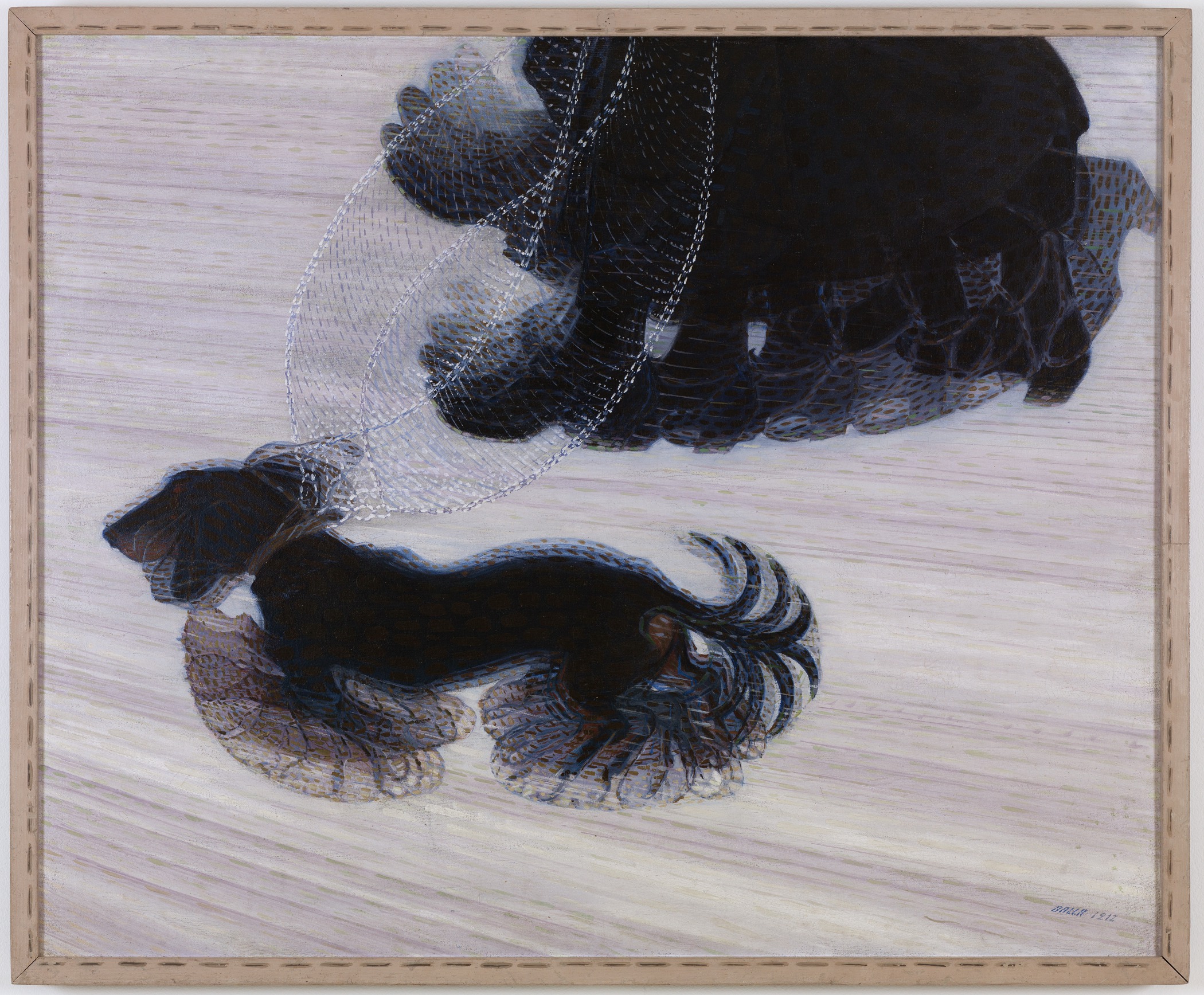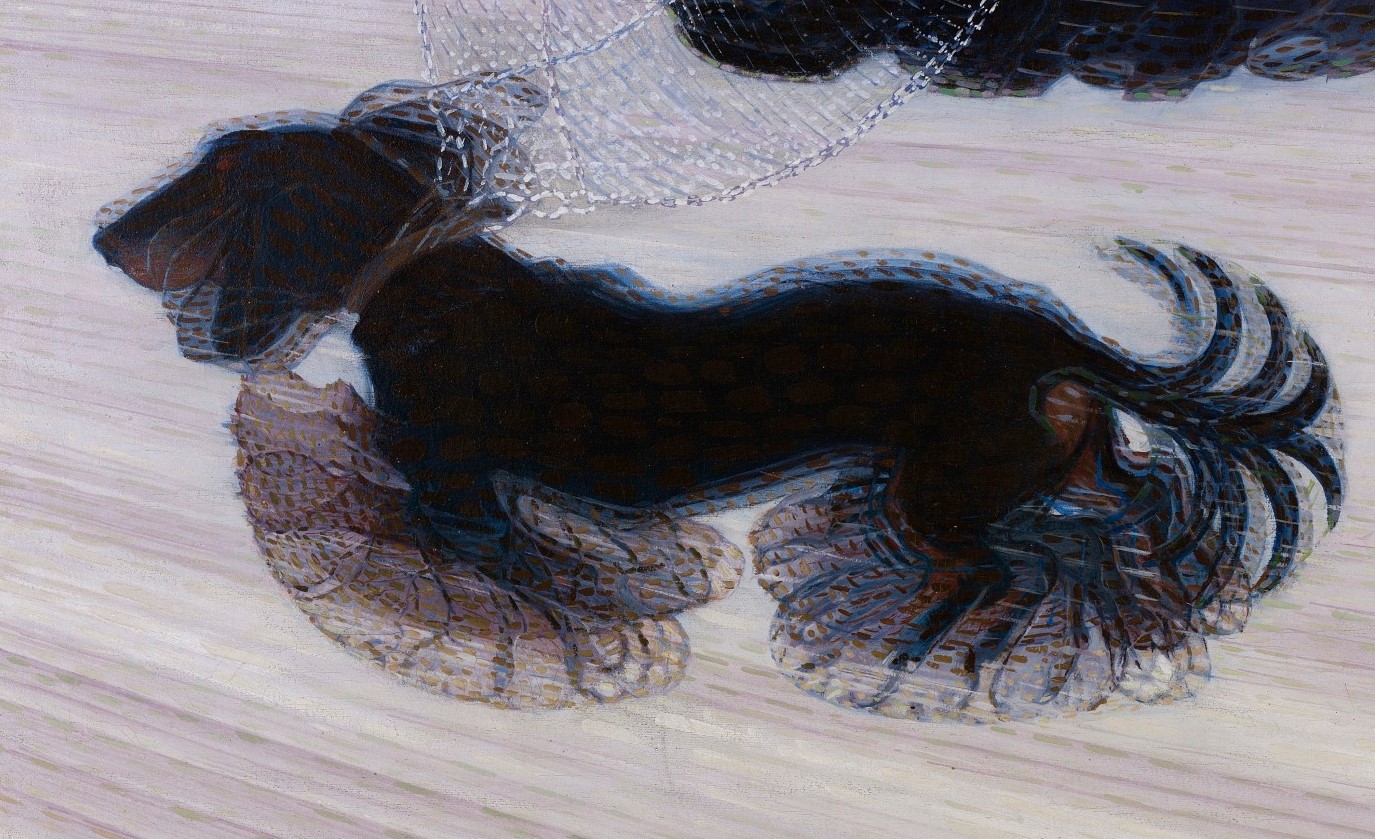
Giacomo Balla painted Dynamism of a Dog on a Leash in oil on canvas in 1912. This painting represents a futurist interpretation of chronophotographic studies of animals in motion. Balla exhibited the painting for the first time in the Galerie Der Sturm’s Autumn Salon in Berlin in 1913. Dynamism of a Dog on a Leash was sold in 1938 to Anson Conger Goodyear. After the death of the owner, the painting became the property of his son, George F. Goodyear, in whose possession it remained until 1984. Since that year, Dynamism of a Dog on a Leash has been part of the collection of the Albright–Knox Art Gallery in Buffalo, New York.
What is Depicted in Dynamism of a Dog on a Leash?
The painting represents a lady walking a dachshund on a leash. Balla composed this painting similarly to composing a photograph – by isolating a micro scene from a walk down a crowded street. In the upper part of the painting, only the feet and the end of the lady’s skirt are visible, the diagonal space of the composition is occupied by a leash, while a dachshund is represented in the lower left corner.
Dynamism of a Dog on a Leash – Analysis
By choosing this subject, Giacomo Balla relied on the legacy of impressionist painting of everyday life. However, the structure of the composition and the relationship between the planes in it separates this painting from the impressionist recording of the experience of modern life and brings it closer to avant-garde aesthetics. In the construction of this composition, Balla used intense close-up and divisionist means of color pulsation, leaving room for the observer to reconstruct the overall scene of which this scene is a part. The dark tones of the lady’s skirt and shoes, as well as that of the dachshund, are contrasted by a diagonally placed silver leash and the ground, which is painted in distinctly light tones. The divisionist technique of complementary color relations contributed to the enhanced vibrancy of the scene, influencing the effect of dynamism that was to be achieved.
In the Technical Manifesto of Futurist Painting from 1910, signed by Giacomo Balla in addition to Umberto Boccioni, Carlo Carrà, Luigi Russolo, and Gino Severini, it is stated Indeed, all things move, all things run, all things are rapidly changing. A profile is never motionless before our eyes, but it constantly appears and disappears. On account of the persistence of an image upon the retina, moving objects constantly multiply themselves; their form changes like rapid vibrations, in their mad career. Thus a running horse has not four legs, but twenty, and their movements are triangular.
In the painting Dynamism of a Dog on a Leash, Balla presented the phenomenon of movement by simultaneously showing numerous aspects of a moving object. Balla combined the principles of Cubism and Futurism by multiplying painted parts of the body and objects, that is, by breaking down the moment of movement in a series of planes.
Balla’s approach to capturing a single moment in a series of planes is directly related to Étienne-Jules Marey’s chronophotography. In 1882 Marey constructed an instrument known as the chronophotographic gun which was capable of taking 12 consecutive frames a second. All those frames were recorded in the same picture. Using this technique, Marey studied the movement of horses, birds, dogs, insects, etc. It was this technique that served Giacomo Balla and other Futurists as an inspiration for the multiplication and superimposition of fragments of objects or parts of the body in order to create the illusion of movement.

Dynamism of a Dog on a Leash FAQs
What type of art is Dynamism of a dog on a leash?
Giacomo Balla’s Dynamism of a dog on a leash belongs to the Futurism art movement. This painting is one of the most famous examples of futurist painting that deals with dynamism using the principles of multiplying parts of the body and objects and breaking down the moment of movement in a series of planes.
What is the meaning of Dynamism of a dog on a leash?
Giacomo Balla’s Dynamism of a dog on a leash presents a female figure busily walking a dachshund. The leading idea of this painting was the exploration of visual capacities for representing beings and objects in motion. Étienne-Jules Marey’s chronophotography technique was of great importance for the creation of this painting. This technique served as inspiration for the visual shaping of the experiences of modern life and speed as its dominant component often emphasized among the Futurists.
Where is Dynamism of a dog on a leash?
Giacomo Balla’s painting Dynamism of a dog on a leash is in the collection of the Albright–Knox Art Gallery in Buffalo, New York.
Related Artworks
Artworks in which Balla explored the phenomenon of movement with chronophotographic means using divisionist technique are Girl Running on the Balcony and The Hand of the Violinist, both from 1912.
